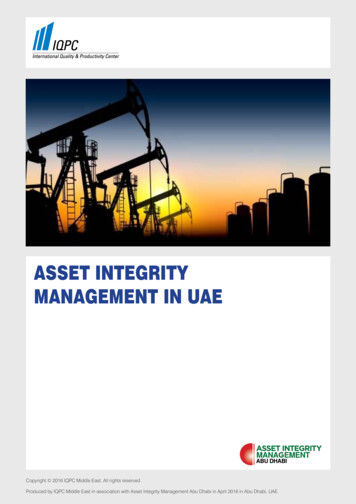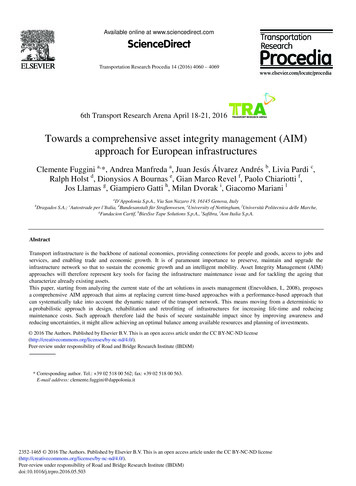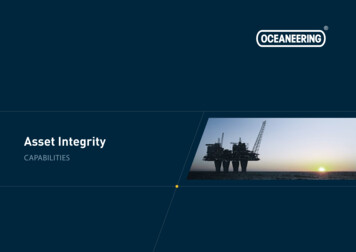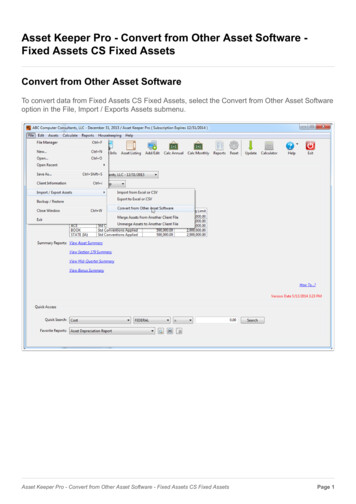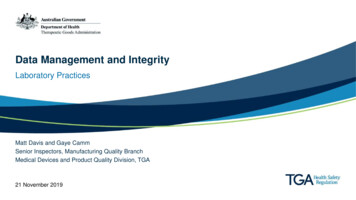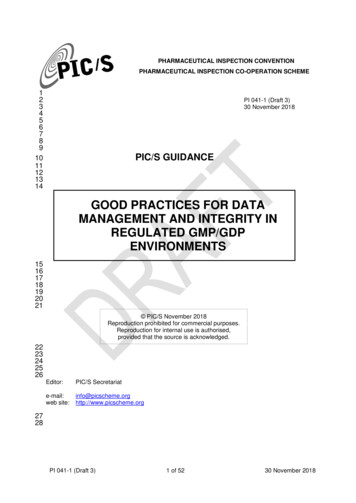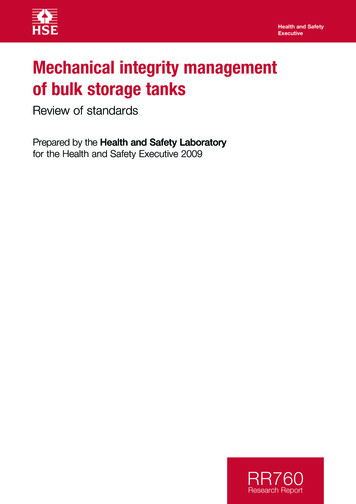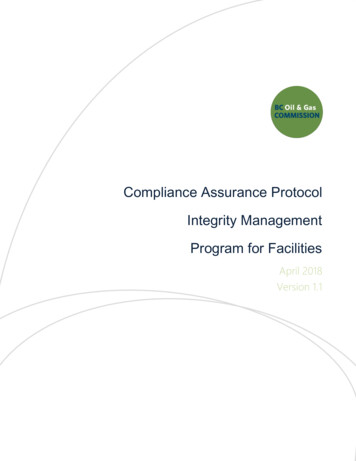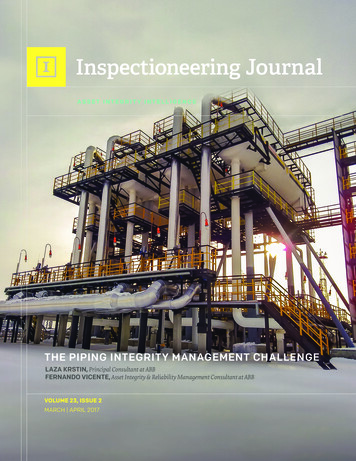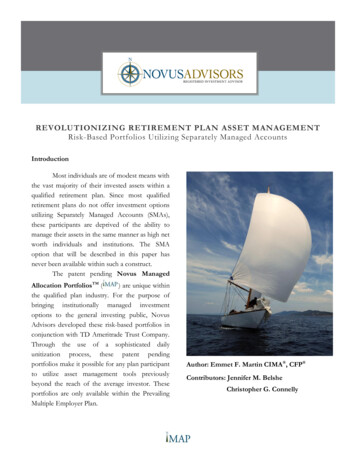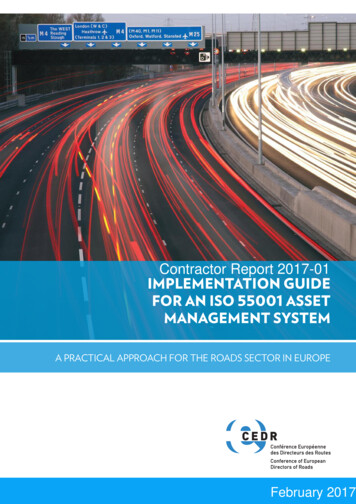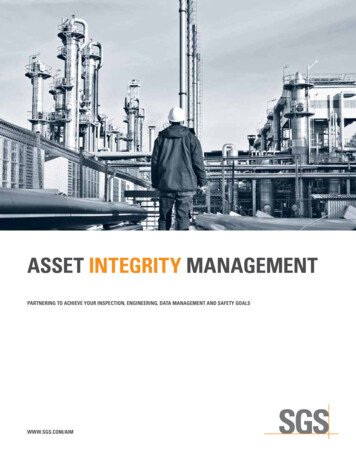
Transcription
asset integrity managementPartnering to achieve your inspection, engineering, data management and safety goalsWWW.SGS.COM/AIM
ASSET INTEGRITY MANAGEMENT– AIMAn asset has integrity when it is operatedand maintained so that the combinationof the likelihood of failure and theconsequence of failure makes the risk topeople, to the environment, and to thecompany as low as reasonably practical.Plant integrity, safety, and reliability aremajor concerns to all plant operatorsand managers. The primary objective ofAsset Integrity Management (AIM) isto maintain the asset in a fit-for-servicecondition while extending its remaininglife in the most reliable, safe, and costeffective manner.In addition to regulatory and companyrequirements, operators of facilities andpipelines have the following businessneedsn Maximizing productionn Reducing lost income due tounplanned shutdownsn Optimizing inspection and maintenancecostsn Maximizing asset valuen Maintaining an auditable systemMost of our clients already have someform of Asset Integrity Managementprogram in place. However, withincreased regulatory oversight, increasedoperating costs, and limited availableresources, implementation of a fullycompliant program is increasinglychallenging for most organizations.RESOURCES TO IMPLEMENT THEProgramSGS is able to effectively partner withour clients to help them overcome thesechallenges.SGS can participate in implementationat any level, from turn-key programdevelopment and implementation tosimple gap-filling services. Our inspectorsare full-time employees trained in oursafety and quality methodologies. Weprovide a full range of NDT servicesincluding advanced inspection techniques.SGS AIM experts provide customizedsolutions at any level of the developmentand implementation process.Program DEVELOPMENTSGS has extensive experience indeveloping and documenting risk-based,time-based, and condition-basedinspection programs for regions all overthe world. Our programs meet API-580,API-581, PAS 55 and other appropriaterequirements as applicable.Program MANAGEMENTSGS has experienced project managersand engineers who can oversee allaspects of the project. Our personnel arealso able to handle the management ofchange process necessary to transitionfrom time-based or condition-based torisk-based inspection programs.SGS experts provide a comprehensivescope of fitness-for-service assessmentsincluding determination of damagemechanisms. We can offer stand-aloneCAD drawing packages to supportclient-based or third-party inspectionprograms and provide a unique set ofvalue adding methodologies includingdata management services, electronicdocument management, and fieldinspection data collection tools.Program GAP ANALYSISSGS experts assist our clients inidentifying the gaps between theirprogram needs and currentimplementation.SGS understands the importance ofinsuring the availability of the real timeKey Performance Indicators (KPI) thatare critical to successful programs.
INTEGRATED APPROACH TO AIMSGS has implemented hundreds of Asset Integrity Management programs worldwide, including nearly two hundred Risk-BasedInspection (RBI) programs. We have found that although there are similarities among all of the programs, no two programs are identical.We put our breadth of knowledge, born from our extensive experience, to work for each of our clients to provide customized solutionsfor their unique needs.Successfully implementing an AIM system requires the right combination of design, engineering, and operationalintegrity. SGS partners with our clients to provide exactly the level of services they need. These services can rangefrom complete turn-key program design and implementation to simple gap-filling to complement a clients existingAIM program. The diagram below shows the scope of services which SGS provides its clients.n Design Verification/Certificationn Regulatory Compliancen Risk Assessment(Hazop)n Fitness for Service (FFS)Assessmentn Material Propertiesn Finite Element AnalysisnnnnMechanical Integrity ManagementPipeline Integrity ManagementRemaining Life CalculationsData Gathering and Field InspectionsDESIGNSAFEGUARDINGSYSTEMSMAINTENANCE &INSPECTIONnnnnRisk Based InspectionRegulatory ComplianceInspection and Maintenance PlanningNon-Destructive and Material TestingVerification/Certification ofn Emergency Escapeand Rescue Systemn Emergency ShutdownSystemn Fire and Gas DetectionSystemn Fire and LightningProtectionn Security Systemn Document Management andControln Pas 55 – Asset ManagementSystem Certification
ENGINEERING SERVICESSGS has been a leader in developmentand implementation of comprehensiveprograms to comply with OSHA’s ProcessSafety Management standards since theirintroduction in 1992.SGS’ engineering staff at our AssetIntegrity Management CompetenceCenter are entirely focused on mechanicalintegrity services.SGS engineers ensure that Recognizedand Generally Accepted Good EngineeringPractices (RAGAGEP) are followed andprovide assistance, inspection, andevaluation based on recognized standardsn ASME Boiler & Vessel Codes(Sec VIII Div I & II)n ASME Piping Codes(B31.1, B31.3, B31.4, B31.8)n Pressure Vessel Inspection (API 510)n Pressure Piping Inspection (API 570)n Pressure Relief Systems (API 520/526)n Tank Evaluations (API 620/650/653)n Risk-Based Inspection (API 580/581)n Fitness for Service (API 579)n Damage Mechanisms (API 571)The Competence Center for Asset IntegrityManagement’s engineering teamspecialize in a variety of disciplines andoffer a complete range of engineeringservices, including the followingAPI-579 ONSERVICESASME SECVIII DIV I &II DESIGNSERVICESTOOLS &SERVICESAPI 580 RBISERVICESFINITEELEMENT& STRESSANALYSISAPI 650, API653 & API 620DESIGN SERVICES AND COMPONENTANALYSISThe SGS AIM team has a vast experiencein new equipment design, pressure vesselcomponent analysis and pipe stressanalysis.The engineers performing the analysishave extensive knowledge andexperience in ASME and internationalstandards, with capabilities such asn Perform new equipment design andpressure vessel component analysisusing popular software as per clientsneedsn Analyzing pressure relieving systemsn Perform intense analysis as per Div IIand include stress maps for thedifferent components of the equipmentusing finite element analysisn Customized engineering analysisFITNESS FOR SERVICE ASSESSMENTSSGS AIM Engineering provides customizedand cost effective assessments for theFFS issues and challenges that arecommon in refining, upgrading, chemical,paper & pulp, and gas processing facilities.Over the last five years SGS has conductedover 12,000 assessments of pressurevessels, piping, and storage tanks inaccordance with API 579-1/ ASME FFS-1.Key features of our FFS assessmentsincluden The ability to utilize advancedtechniques such as finite elementanalysis to assess equipmentn Industry leading turnaround for theFFS assessments meaning reducedshutdown time, and more effectiveremediationn Extensive practical experience whichallows SGS to recommend practicalsolutions to difficult FFS problemsn Identification of alternate serviceoptions which could allow operationwith enhanced equipment performancen Recommendation of effectiveremediation and repair approachesRISK SERVICESSGS Reliability and Risk ManagementProgram (RRMP) can be linked withexisting inspection programs both locallyand globally.The program provides improvedeffectiveness of existing programs throughn Providing emphasis on lean inspectionstrategies, safety compliance, failureprevention and focus on criticalcomponentsn Damage mechanism review andassessmentn Identify the existing risk categoryand provide cost effective measuresthrough inspection program to reduceand contain the riskn Review and compile historicalinspection data in preparation for orin support of RBI implementationn Assist in acquisition of Owner/UsercommissionsFIXED EQUIPMENT DEGRADATIONMECHANISM SERVICESSGS AIM engineering departmentincludes engineers with experienceevaluating damage mechanisms forequipment including pressure vessels,pressure piping, storage tanks, heatexchangers, heaters, and specializedequipment.This includes on-stream assessmentas well as investigation of root causesof major industrial accidents.SGS AIM can provide support servicesfor identification of fixed equipmentdegradation mechanismsn Identifying degradation deviceseffecting the reliability of fixedequipmentn Recommending acceptable criteriafor degradation devices to becomeeffectiven Recommending lean inspectionstrategies, inspection plans and criticalinspection locationsn Identifying internal as well as externalcorrosion ranges
ASSESSMENT AND ANALYSISn Defining effect of high temperatureand erosionn Preparing detailed reports describingtype of degradation mechanisms,effect of degradation mechanisms,process streams, mass balance etc.n Identifying active and accuratedegradation mechanisms forimplementation in risk-basedinspection and fitness for servicen Provide customized reports to showthe balance of cost and effectivenessfor the degradation mechanismsunder reviewFINITE ELEMENT ANALYSIS (FEA)SGS offers the complete range of FFSassessments from initial assessmentthrough Level III (Finite Element) analysis,as well consulting for cause and effectanalysis.Using the most current technology, SGSengineering experts have the ability toutilize advanced techniques such as finiteelement analysis to assess equipment.Our industry leading FFS assessmentsmean reduced shutdown time, and moreeffective remediation.Key features of FEAn Develop 2D and 3D models of pressurevessel and piping systemsn Analyze external loads on nozzlesn Evaluate load cases that contribute tofailure in piping and pressure vesselcomponentsn Analysis capabilities: Linear, materialnon-linear, steady state transientthermal, stress stiffeningn The nozzle evaluation reports include:allowable loads, flexibility factors,stress intensification factorsn Compare the results with acceptancecriteria listed in ASME Sec VIII Div I & IIn Perform fatigue calculations for pipingand pressure vesselsn API-579 Level 3 Assessmentn Self contained, 3D viewer is providedto the client for reviewing the resultsABOVE GROUND STORAGE TANKSERVICESOur experience in engineering servicesinclude verifying new tank designconstructed to API 650, API 620, UL-142and API 2000.Comprehensive analysis and reportingcapability includingnnnnnnnMaximum fill heightSettlementUpliftWind loadingVenting requirementsNozzle loadingsFrangible GAPPLICATIONDEVELOPMENT
DATA MANAGEMENT SOLUTIONSEven moderate scale Asset IntegrityManagement programs produce massivequantities of data that must be effectivelymanaged. Because the databases thatresult from AIM implementations can beso large, even simple data entry taskscan involve so many data points that theyoverwhelm even well staffed inspectiondepartments.Furthermore, most standard corrosionmonitoring software packages are limitedin their ability to accept, let alone correlatethe full range of supporting documentsand information required for compliance.And almost none of the standardpackages can automatically link data inthe database to CAD drawings or fieldsketches.Another significant weakness of standardsystems is that they typically only identifyvisual observations as open or closed,and provide no effective means to trackwhether or not the remediations arecompleted within the client’s deadlines.SGS provides services which can addressthese common data management issues.SGS data analysts provide expert corrosiondata entry support to our clients using awide range of commercial softwarepackages including SAP, IBM Maximo,UltraPIPE, PCMS, Credo, etc. As a result,SGS has the flexibility to support ourclients existing programs, rather thancompel them to adopt a restrictedcorrosion monitoring software approach.In addition, through specialized protocols,SGS data analysts have successfullylinked the corrosion monitoring data instandard industry software to fieldsketches, CAD drawings, and evenphotographs. This process providesour clients’ inspection and maintenancepersonnel with actionable drawingswithout having to go through thetraditional process of hand markinginspection due and retirement duedrawings based on paper inspectionreports. This SGS method improvesthe accuracy of the resulting drawingsrelative to traditional methods whileactually reducing the time to producethe required documents.SGS can also provide a MechanicalIntegrity Management System (MIMS)which interfaces with the client’s existingcorrosion monitoring software. TheSGS MIMS is a web-based applicationwhich facilitates data entry, tracking ofvisual observations, reporting of keyperformance indicators, and electronicdocument management. The belowfigure shows the principle of our MIMSand gives an overview of data entriesand output deliverances.Regulatory DocumentationKEY PERFORMANCE INDICATORSEntered into the MIMS system –Available for verification and auditKey performance indicators are an output of the MIMSinspection program and remediation of program findinCORROSION MONITORING INSPECTION DATAGenerated and entered into the MIMS system –Actionable drawings can be readily createdVISUAL INSPECTION DATAEntered into the MIMS system –Allows tracking of findings and their remediationEQUIPMENT DOCUMENTATIONEntered into the MIMS system –Available to verify compliance with applicable requirementsINSPECTION DOCUMENTATIONEntered into the MIMS system –Readily accessible by authorized usersINSPECTION DRAWINGSGenerated and loaded into the MIMS systemfor immediate accessibilityFacility INSPECTION DRAWING PACKAGEAvailable in the system in block style or single line isometric form –Linked to facilitate accessMIM
The data entry portion of MIMSautomatically distributes data intoindustry standard databases, effectivelyreducing repetitive data input. In addition,built-in error checkin
Our programs meet API-580, API-581, PAS 55 and other appropriate requirements as applicable. PrOGrAM MAnAGeMent SGS has experienced project managers and engineers who can oversee all aspects of the project. Our personnel are also able to handle the management of change process necessary to transition from time-based or condition-based to risk-based inspection programs.
